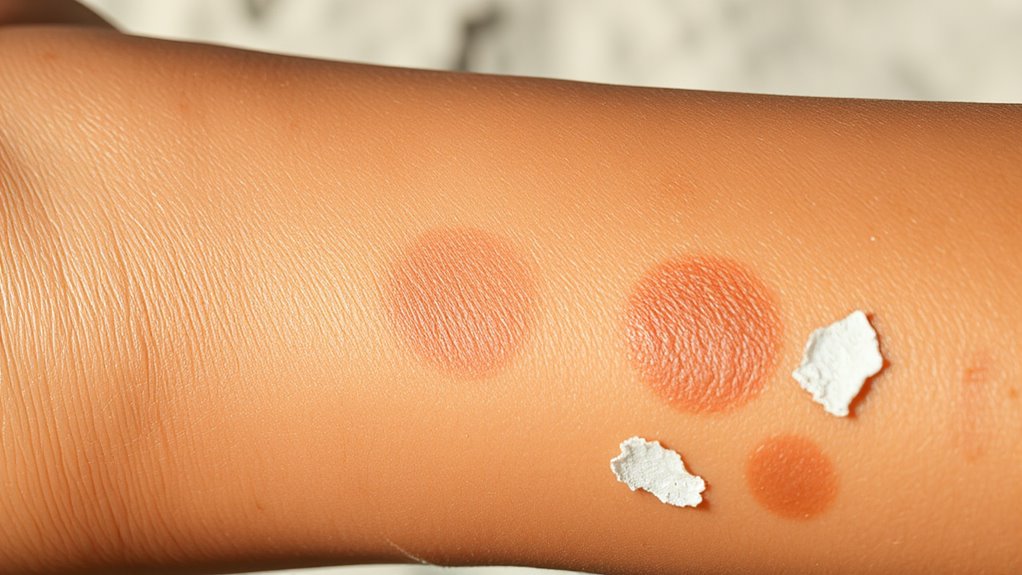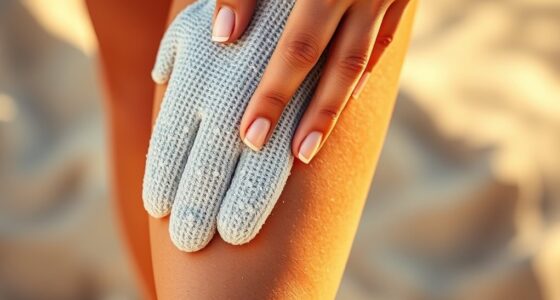Tanning damages your skin at every level, speeding up aging and increasing your risk of skin cancer. UV rays break down collagen and elastin, leading to wrinkles, sagging, and uneven skin tone. Both indoor and outdoor tanning expose your skin to harmful radiation that causes DNA damage, boosting melanoma and other skin cancers. If you want to protect your skin and maintain a youthful appearance, understanding the risks involved can help you make better choices.
Key Takeaways
- Tanning accelerates skin aging, causing wrinkles, sagging, and loss of elasticity due to UV damage to collagen and elastin fibers.
- UV exposure creates DNA lesions leading to mutations, increasing the risk of skin cancer, including melanoma.
- Both indoor and outdoor tanning cause skin damage, hyperpigmentation, and uneven skin tone, regardless of perceived safety.
- Repeated tanning damages skin’s resilience, resulting in premature aging signs and compromised skin health over time.
- Protecting skin with SPF, protective clothing, and avoiding tanning significantly reduces long-term damage and promotes healthier skin.
How UV Rays Damage Skin Cells and Lead to Cancer

Ultraviolet (UV) rays from the sun directly damage your skin cells’ DNA by creating lesions like cyclobutane pyrimidine dimers (CPDs) and (6–4) photoproducts. These lesions disrupt normal base pairing, leading to mutations if not repaired properly, which can promote skin cancer. UVB rays cause direct DNA damage, while UVA contributes indirectly by generating reactive oxygen species (ROS) that oxidize DNA bases. This oxidative stress can cause strand breaks and mutations, overwhelming your skin’s repair mechanisms. When these lesions persist, they increase your risk of developing skin cancer. Although your body has repair processes like nucleotide excision repair to fix UV-induced damage, deficiencies in these pathways heighten your vulnerability. Environmental considerations such as minimizing exposure during peak sunlight hours can help reduce damage and protect your skin health. Additionally, ongoing research into DNA repair mechanisms aims to develop better protective strategies against UV damage. Understanding skin cell responses to UV exposure can also assist in designing effective prevention methods. Recognizing UV-induced DNA lesions plays a crucial role in advancing skin cancer prevention and treatment strategies. Furthermore, emerging technologies in skin protection are being developed to enhance natural defenses against UV radiation.
The Myth of Safe Tanning and Its Hidden Risks

Many people believe that tanning is a safe way to improve their appearance or boost vitamin D levels, but this is a dangerous misconception. UVA rays penetrate deeply, causing skin aging and increasing melanoma risk, while tanning beds emit UVA radiation three times stronger than sunlight, raising your skin cancer risk. Indoor tanning isn’t safer than sun exposure; both pose similar or higher dangers. Although some claim tanning helps produce vitamin D, the benefits are overstated and don’t outweigh health risks. Many fall for marketing that downplays these dangers, believing in false safety claims. Tanning, whether indoors or outdoors, leads to skin damage, premature aging, and higher cancer risks. There’s no such thing as a safe tan, and understanding these risks is essential for your skin health. Proper skin care and sun protection measures are crucial to minimize damage.
Indoor Tanning and Its Link to Increased Skin Cancer Rates

Indoor tanning markedly increases your risk of developing skin cancer, especially if you start before age 35. If you begin tanning indoors early, your melanoma risk jumps by 59 to 75 percent, and women under 30 are up to six times more likely to develop melanoma than those who avoid indoor tanning. Studies show that nearly all women diagnosed with melanoma before 30 had used tanning beds. Each session adds to your cumulative risk. The UV radiation from these devices, similar to or stronger than the sun’s, damages your skin’s DNA, accelerating carcinogenesis. Over 419,000 skin cancer cases in the U.S. annually are linked to indoor tanning, including melanoma, basal, and squamous cell carcinomas. The evidence clearly shows that indoor tanning substantially raises your chances of developing deadly skin cancers. Vetted – Mother Baby Kids. Additionally, the UV radiation exposure from tanning beds can cause premature skin aging and other skin damage, further emphasizing the health risks involved.
The Impact of Tanning on Skin Aging and Appearance
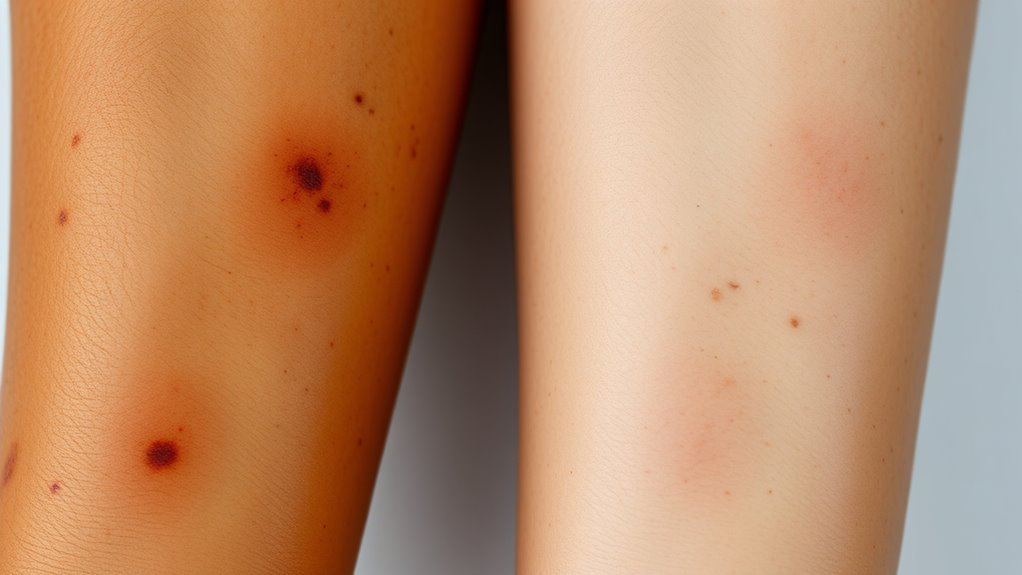
Exposure to tanning, whether indoors or outdoors, accelerates the visible signs of aging by damaging the skin’s structural components. UV rays break down collagen and elastin, leading to wrinkles, fine lines, and sagging skin. Repeated exposure causes a leathery texture and loss of elasticity, making your skin appear aged beyond your years. Hyperpigmentation and dark spots form as melanin production becomes irregular under UV stress. Over time, these changes can make your skin look weathered, uneven, and dull. Indoor tanning intensifies these effects since tanning beds emit UV radiation up to 15 times stronger than sunlight, speeding up aging signs. The damage is cumulative, often showing up years later, with up to 90% of aging signs linked to sun exposure. Understanding how asset division laws influence property settlement can help you better navigate the legal process should you decide to divorce. Additionally, proper skincare routines can help mitigate some of these effects and protect your skin’s health.
Preventative Measures to Protect Skin Health
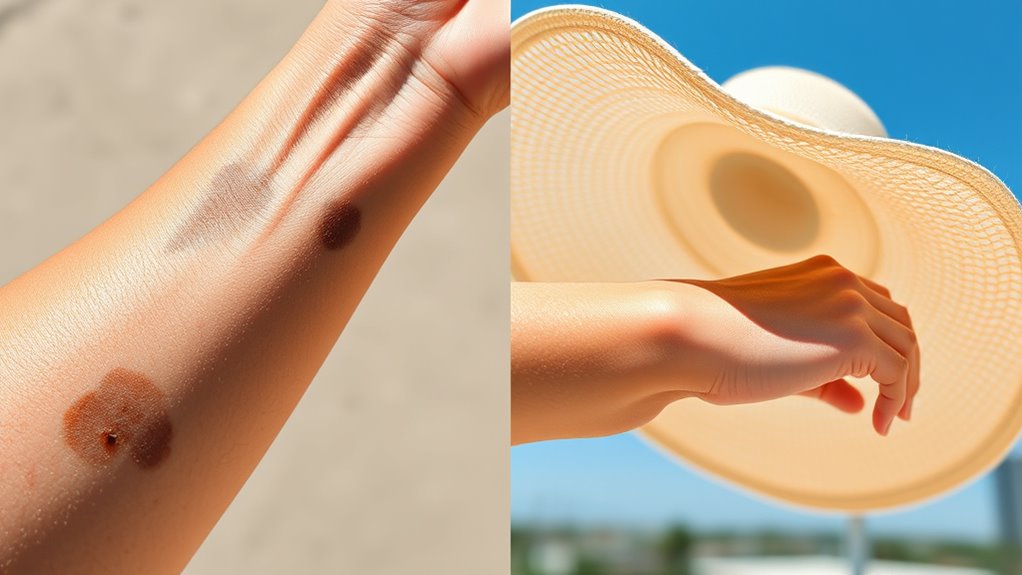
Protecting your skin from UV damage requires a combination of effective habits and protective measures. Start by using mild cleansers and avoiding hot water to keep your skin’s natural moisture balanced. Be gentle when drying, patting instead of rubbing, and thoroughly dry after washing. Wear protective clothing like long-sleeved shirts, wide-brimmed hats, and UV-blocking sunglasses to shield exposed skin. Use fabrics with UPF ratings when possible, and don’t rely solely on sunscreen—combine it with clothing for better protection. Apply broad-spectrum SPF 30 or higher sunscreen daily, reapplying every two hours or after water exposure. Avoid artificial tanning devices, as they emit harmful UV rays. Additionally, keeping your skin hydrated with moisturizers and drinking plenty of water helps maintain its barrier function. Proper sun protection also involves understanding UV radiation exposure, which can vary based on geographic location and time of day. Being aware of UV index levels can help you plan your outdoor activities to minimize risk. Regularly checking the sun protection factor of your skincare products ensures adequate coverage. Finally, choosing sunscreen with high SPF can provide extra protection against UV damage.
Long-Term Consequences of Repeated UV Exposure
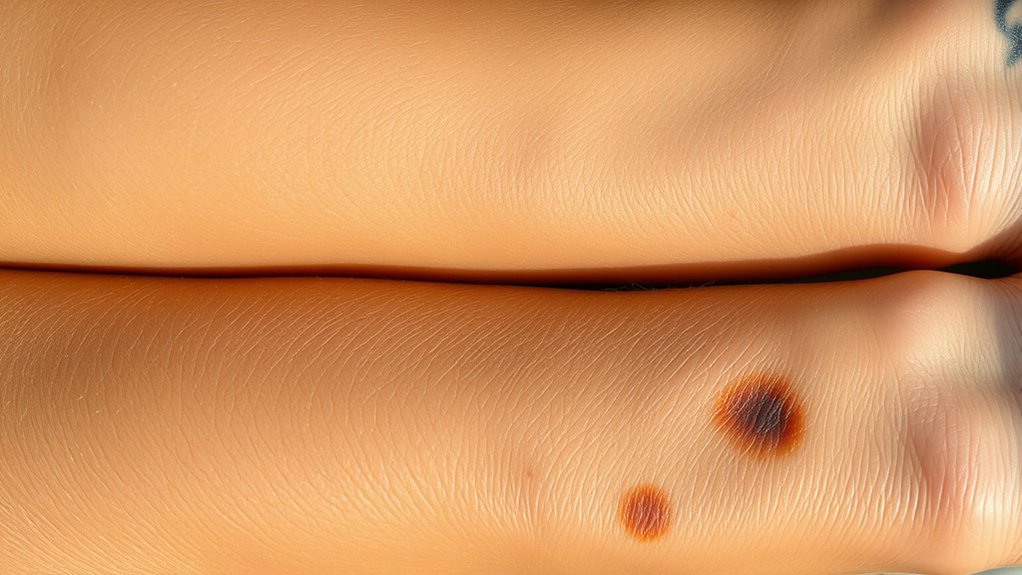
Repeated UV exposure can cause significant long-term damage to your skin, leading to premature aging, increased cancer risk, and pigmentary changes. UV rays break down collagen and elastin, causing wrinkles, sagging, and loss of firmness. Your skin becomes dry, rough, and less resilient, with uneven tone and blotchy pigmentation appearing over time. UV radiation damages DNA in skin cells, raising your risk of melanoma, basal cell carcinoma, and squamous cell carcinoma. Cumulative exposure often results in actinic keratoses—precancerous growths that can progress to cancer if untreated. Protective practices can significantly reduce these risks and promote healthier skin. Long-term UV damage also weakens skin structure, causing sagging and slow healing. These changes leave your skin fragile, aged, and more vulnerable to environmental harm, emphasizing the importance of protecting your skin from repeated UV exposure. Additionally, sun protection measures such as using sunscreen and wearing protective clothing can help mitigate these effects. Embracing failure in protective practices can lead to better habits and outcomes over time. Recognizing the role of skin resilience can help motivate consistent protective behaviors and improve long-term skin health.
Frequently Asked Questions
How Does Tanning Affect Skin’S Natural Ability to Repair Itself?
Tanning impacts your skin’s ability to repair itself by increasing DNA damage through UV exposure. When you tan, your skin tries to repair this damage with mechanisms like nucleotide excision repair, but repeated exposure overwhelms these processes. Over time, this buildup of damage weakens your skin’s natural repair capacity, accelerates aging, and raises your risk of mutations that can lead to skin cancer. Tanning, consequently, compromises your skin’s health and resilience.
Are Certain Skin Types More Vulnerable to Tanning-Related Damage?
Think of your skin as a fortress; some walls are stronger than others. Your skin type influences how vulnerable you are to tanning damage—fair skin, with less melanin, is like a fragile wall, more prone to burns and cancer. Darker skin offers some natural protection, but it’s not invincible. No matter your skin type, tanning causes damage, so protect yourself with sunscreen and avoid unnecessary UV exposure.
Can Tanning Beds Cause Skin Cancer Even With Brief Use?
Yes, tanning beds can cause skin cancer even with brief use. You might think short sessions are safe, but research shows any exposure to UV radiation from tanning beds damages your skin’s DNA, increasing your risk of melanoma, basal cell carcinoma, and squamous cell carcinoma. Even infrequent or low-dose tanning can initiate cellular changes that lead to cancer over time, so it’s safest to avoid tanning beds entirely.
What Are the Immediate Skin Effects After Tanning Sessions?
You wonder what happens immediately after tanning. You might notice redness creeping across your skin, a telltale sign of UV exposure. It could escalate to burns if you’re sensitive, leaving your skin dry and itchy. Rashes or allergic reactions might also appear suddenly. These effects happen quickly, warning you that your skin is reacting to the UV rays, making you realize the immediate impact of tanning on your skin’s health.
How Effective Are Sunscreens in Preventing Tanning-Related Skin Damage?
Sunscreens help reduce tanning-related skin damage, but they can’t fully prevent it. When you apply broad-spectrum sunscreen correctly, it blocks most UVB rays and some UVA rays, which lessens your risk. However, some UV rays still penetrate, especially if you miss spots or don’t reapply often. So, while sunscreen offers significant protection, limiting sun exposure and wearing protective clothing are essential for better skin health.
Conclusion
Remember, every time you tan, you’re playing with fire, risking your skin’s future like a delicate house of cards vulnerable to a gust. Protect your skin by avoiding risky UV exposure and embracing safer choices. Think of your skin as a treasured garden—nurture it with care, shield it from harm, and it’ll glow with health and vigor for years to come. Your future self will thank you for making smart, sun-safe decisions today.
